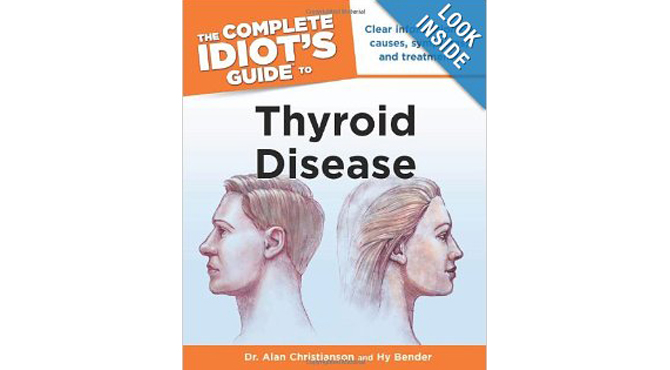January is Thyroid Awareness Month, and so we interviewed Hy Bender, a thyroid cancer survivor and co-author of The Complete Idiot’s Guide to Thyroid Disease with Dr. Alan Christianson, so Hy can share some crucial information you should be familiar with when it comes to your thyroid.
This interview is Part I in our blog series, and addresses what the thyroid is and serves as an introduction to the basics of thyroid disease. Read on — Hy did an excellent job educating us in a way that makes the information very easy to digest.
DASHA®: Where is the thyroid located, and what does it look like?
HY: Your thyroid is a butterfly-shaped gland that resides in your neck. It’s wrapped around your windpipe, just above your collarbone and below your Adam’s apple. Its name stems from the Greek word for “shield” (another metaphor for its shape).
Your thyroid consists of left and right “wings,” called lobes, connected by a middle section called the isthmus. The two lobes do the same job, each performing half of the necessary labor. They also effectively back each other up; if anything ever goes wrong with one lobe, the other can take over the entire workload.
The thyroid’s shape varies by gender. If you’re a man, it’s narrower and thicker; if you’re a woman, it’s longer and flatter. The Adam’s apple tends to be visible in men only. Women have an Adam’s apple too—it’s merely the cartilage between your thyroid and larynx—but the shape of the thyroid typically hides it from sight. (Some ancient Greeks believed the purpose of the thyroid was to provide women with a pleasing neckline.)
Your thyroid isn’t very large; it’s roughly the width and thickness of four credit cards stacked on top of each other, and weighs 10-30 grams (0.35-1.06 ounces).
DASHA®: What does the thyroid do, and why is it important?
HY: The thyroid has just one job, but it’s of immense importance: It makes hormones that regulate the energy level, growth, and reproduction of every cell of your body. That means your brain, heart, lungs, liver, skin, tissues, and all other body parts depend on your thyroid to stay “powered up” and active, and to remain healthy by generating new cells to replace old ones.
In other words, your thyroid is your body’s thermostat, raising or lowering the amount of activity taking place based on your body’s current needs. (Put another way, your thyroid sets your metabolism.)
Your thyroid normally creates just the right amount of hormones, keeping all your cells active and operating smoothly. If your thyroid becomes defective, though, you may experience a bewildering set of disparate ailments because of the thyroid’s impact on every part of your body.
DASHA®: What are the most common types of thyroid disease?
HY: The two most pervasive thyroid-related diseases are hypothyroidism and hyperthyroidism.
If you’re hypothyroid, your thyroid is underperforming. This is by far the most common of all thyroid diseases, comprising over 80 percent of thyroid cases.
When your body doesn’t have enough thyroid hormones, your cells will reduce their conversion of glucose into energy. The unused glucose will be stored in your body as fat, causing you to gain weight. You’ll also start feeling increasingly tired as your energy supply winds down.
In addition, your body reducing the generation of new cells may cause your nails to grow dry and brittle, your skin to become rough and thin, and your hair to thin and fall out. At the same time, the lowered brain activity may make you confused, forgetful, and even dangerously depressed.
You can experience any of these symptoms, and/or dozens of others, because the “energy slowdown” caused by your underperforming thyroid will have different effects on different parts of your body.
If you’re hyperthyroid, your thyroid is overperforming. This accounts for roughly 15 percent of thyroid cases.
When your body has an overabundance of thyroid hormones, your cells will turn glucose into energy at a much faster pace than normal. Once the available glucose runs out, your body will start turning your fat cells into glucose to keep up with the demand for more fuel, causing you to lose weight. You might actually be happy about the latter. However, you’ll start feeling increasingly manic from the extra energy.
You may also feel exceptionally anxious, nervous, irritable, or “shaky,” and experience panic attacks. In addition, your heart rate may increase to the point of pounding in your chest, which poses the risk of a heart attack.
Hyperthyroidism is a more dangerous disease than hypothyroidism, and it requires more complex treatment. However, in most cases it’s thoroughly manageable.
DASHA®: How are the most common forms of thyroid disease diagnosed?
HY: Getting properly diagnosed can be tricky because the thyroid affects every part of your body. As a result, a malfunctioning thyroid can create just one seemingly random symptom, or a bunch of symptoms that aren’t clearly related, leading many doctors to focus on something other than your thyroid as the cause.
For example, if you’re depressed, a doctor might prescribe anti-depressants without even considering the issue could be an underactive thyroid that’s lowering the activity of your brain.
Similarly, if you’re gaining weight for no reason, a doctor might suggest you eat less and exercise more when the real problem is that your metabolism has changed.
Ask your doctor for thyroid blood tests as part of your exam. More specifically, be sure to ask your doctor to run tests for TSH, free T4, and free T3, which all provide information about the level of thyroid hormones in your body. In addition, ask your doctor to run a test for thyroid antibodies, as this can reveal whether your immune system is attacking your thyroid, which is the most common cause of hypothyroidism.
DASHA®: How are the most common forms of thyroid disease treated?
HY: If you’re hypothyroid—that is, don’t have enough thyroid hormones—then you’ll need thyroid medication. This typically consists of taking one or more pills first thing every morning exclusively with water, and then consuming nothing for an hour to allow the medication to fully enter your bloodstream.
The thyroid medication that’s best for most people with hypothyroidism is natural thyroid, also called desiccated thyroid, such as Nature-Throid or Armour. However, doctors will typically prescribe Synthroid, which is created from chemicals in a lab and lacks some of the hormones that a pill such as Nature-Throid provides. (Much more about synthetic vs. natural thyroid medication—as well as generic vs. brand name medication—is covered in Chapters 3 and 8 of our book.)
If you’re hyperthyroid—that is, have an overabundance of thyroid hormones—your situation is more complicated.
If you have a mild case of hyperthyroidism, you might be able to treat it with low-impact remedies such as fluoride, L-Carnitine, and/or goitrogens (e.g., broccoli, cauliflower, cabbage, Brussels sprouts, kale).
If you have a severe case of hyperthyroidism, though, you’ll probably need to turn to medication such as Tapazole (which we prefer), or to radioiodine ablation, which uses radioactive iodine to destroy a substantial percentage of the thyroid’s cells, making it too small to overproduce hormones.
Once your hyperthyroidism is treated, you’ll either stabilize into a normal thyroid state or, more commonly, become hypothyroid. In the latter case, the treatment is the same as it is for those who start out hypothyroid: taking thyroid medication such as Nature-Throid daily.
An underperforming thyroid won’t necessarily have a major impact on you. Aside from needing to take a pill or two when you wake up every morning, in the vast majority of cases you can live a thoroughly normal and healthy life.
Be sure to check the DASHA® blog next week, when Hy answers our questions on thyroid cancer.
DASHA® wellness & spa is a luxury lifestyle brand and New York City-based wellness center created to offer a truly holistic approach to wellness. To learn more, visit dashawellness.com.






